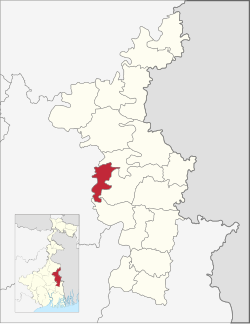Population
As per the 2011 Census of India, Nabadwip CD Block had a total population of 135,314, of which 76,214 were rural and 59,073 were urban. There were 69,696 (52%) males and 65,618 (48%) females. The population below 6 years was 15,537. Scheduled Castes numbered 19,612 (14.49%) and Scheduled Tribes numbered 1,642 (1.14%). [10]
As per the 2001 census, Nabadwip block had a total population of 121,793, out of which 62,765 were males and 59,028 were females. Nabadwip block registered a population growth of 16.51 per cent during the 1991–2001 decade. Decadal growth for the district was 19.51 per cent. Decadal growth in West Bengal was 17.84 per cent. [11] [12]
There are several census towns in Nabadwip CD Block (2011 census figures in brackets): Bamanpukur (9,137), Tiorkhali (11,148), Bablari Dewanganj (6,806), Gadigachha (14,085), Majdia (7,831), Char Maijdia (5,013) and Char Brahmanagar (5,053).
Large villages (with 4,000+ population) in Nabadwip CD Block were (2011 census figures in brackets): Charkashthasali (6,304), Ballaldighi (4,613), Pansila (8,200), Bankar Dhopadi (4,156), Gadkhali (5,057) and Mohisunra (15,910).
Language and religion
| Religion in Nabadwip CD block (2011) [13] |
|---|
| | |
| Hinduism | | 61.39% |
| Islam | | 38.20% |
| Other or not stated | | 0.41% |
In the 2011 census, Hindus numbered 83,069 and formed 61.39% of the population in Nabadwip CD Block. Muslims numbered 51,685 and formed 38.20% of the population. Christians numbered 44 and formed 0.03% of the population. Others numbered 516 and formed 0.38% of the population. [13]
In the 2001 census, Hindus numbered 79,059 and formed 64.91% of the population of Nabadwip CD Block. Muslims numbered 42,636 and formed 35.00% of the population. In the 1991 census, Hindus numbered 69,549 and formed 66.53% of the population of Nabadwip CD Block. Muslims numbered 34,961 and formed 33.45% of the population. [14]
Bengali is the predominant language, spoken by 99.06% of the population. [15]
